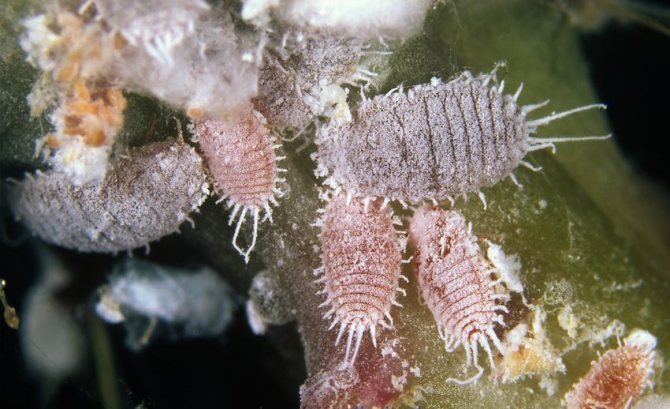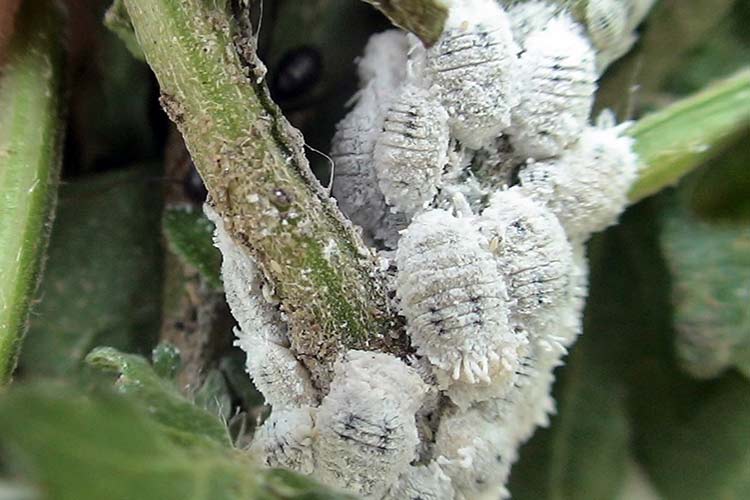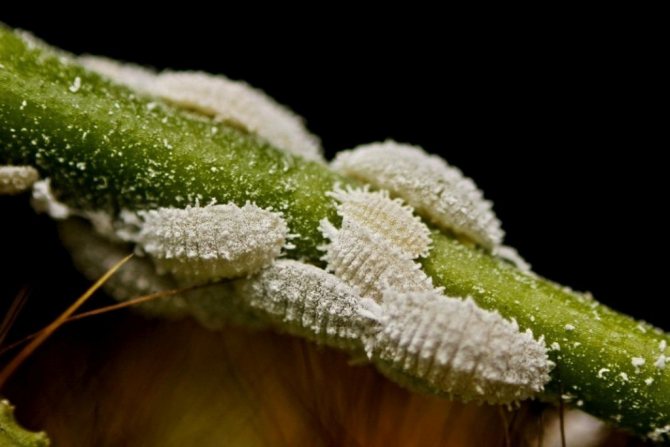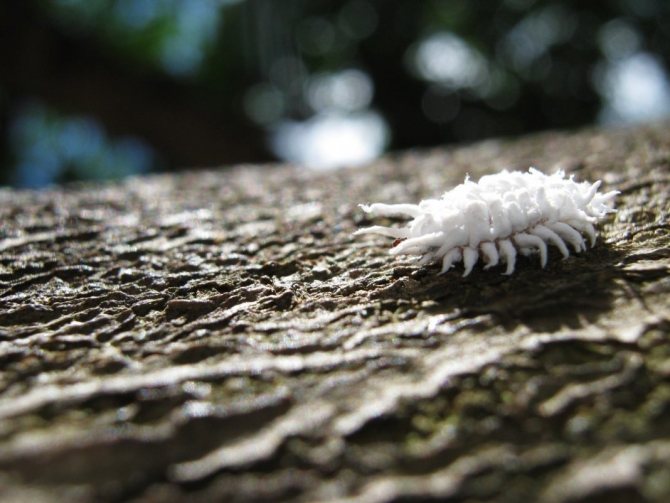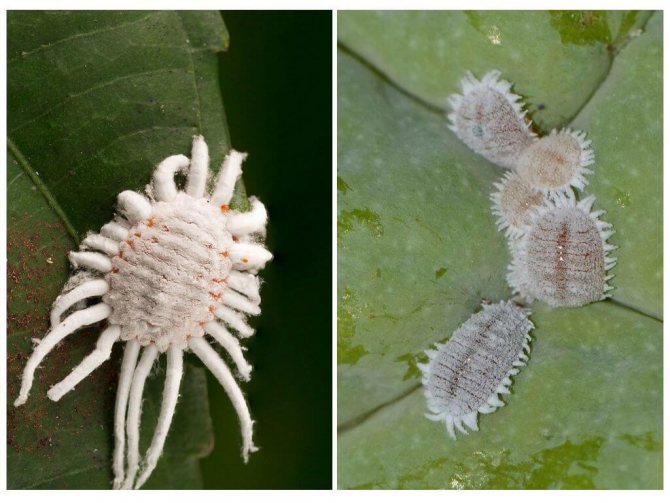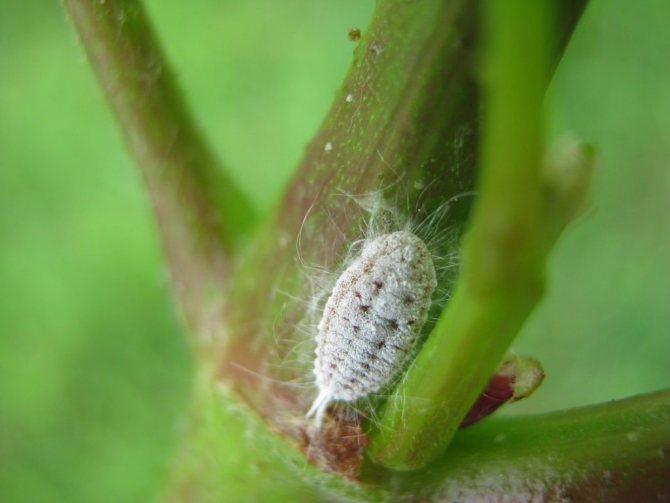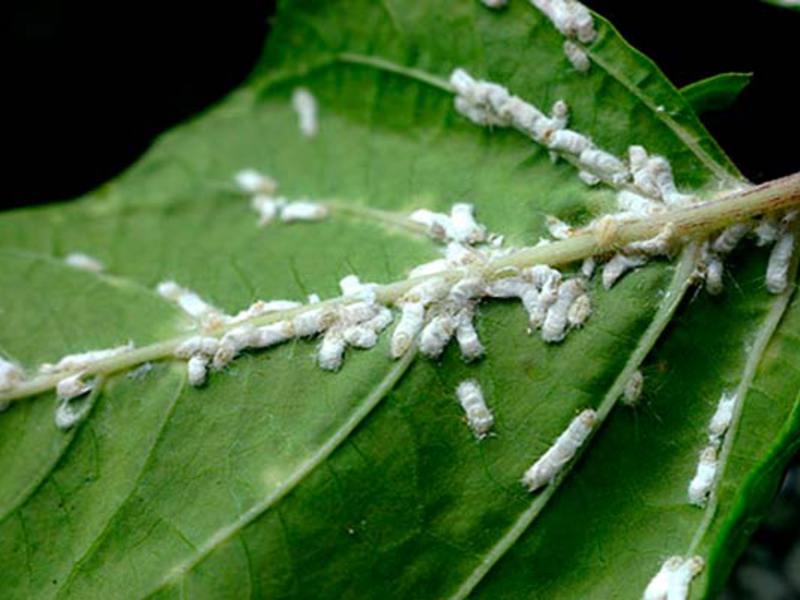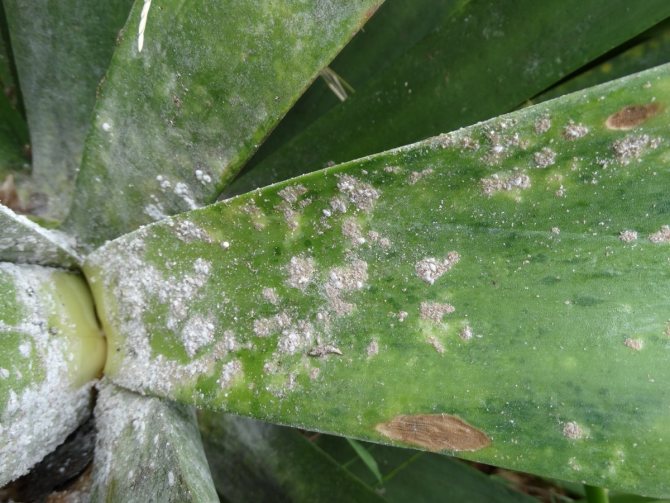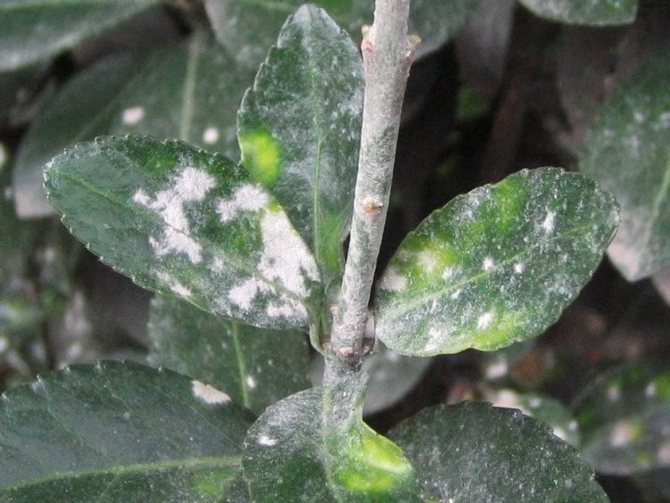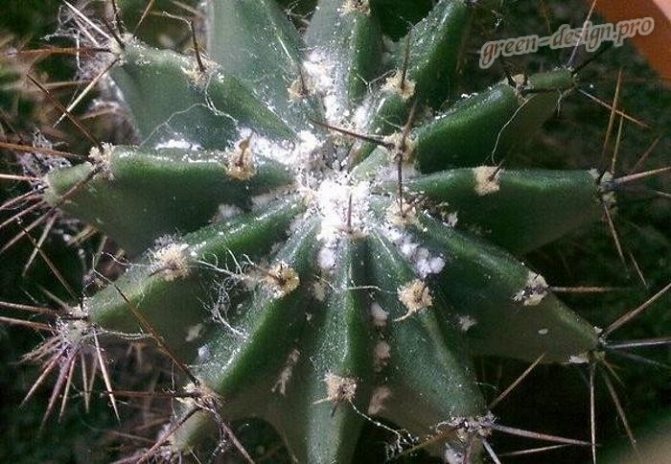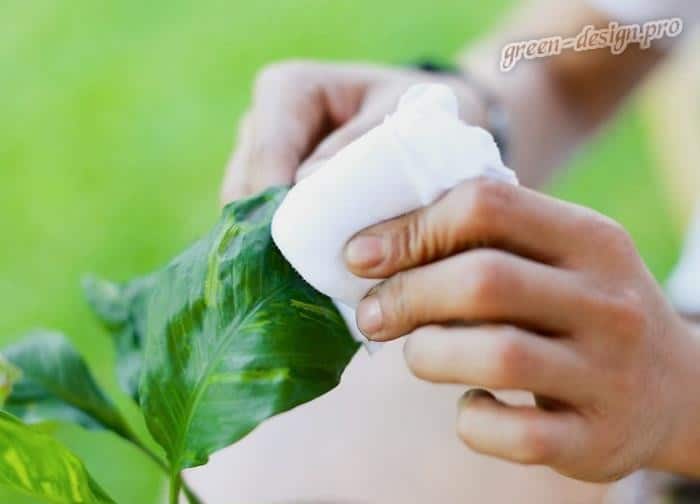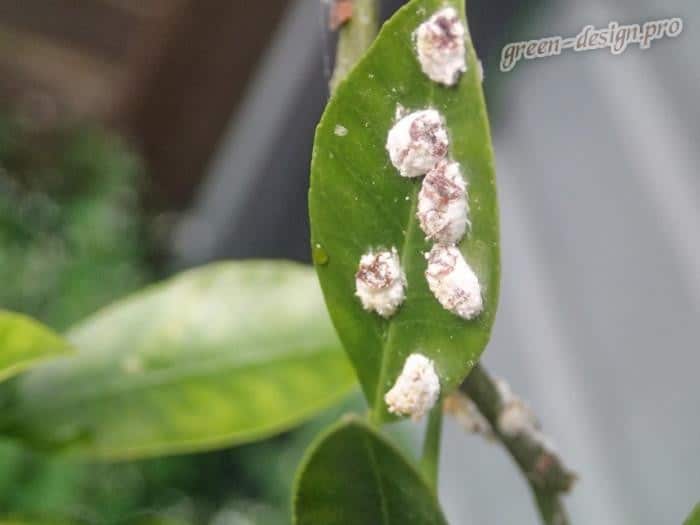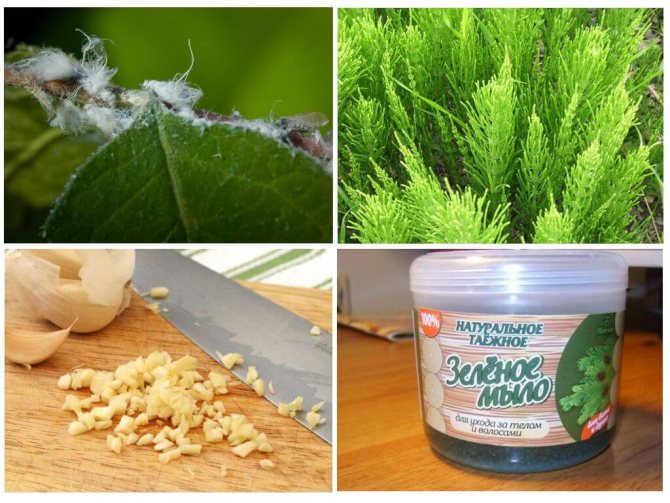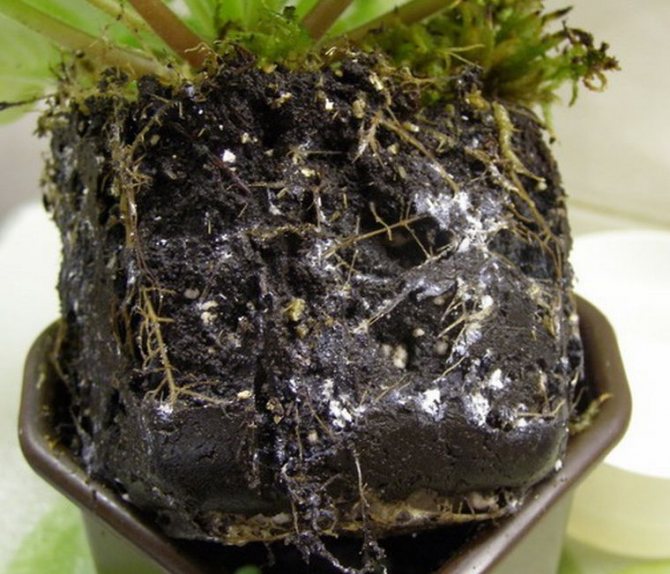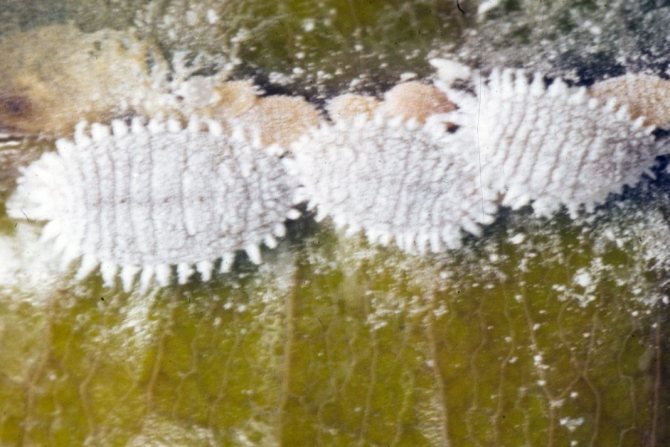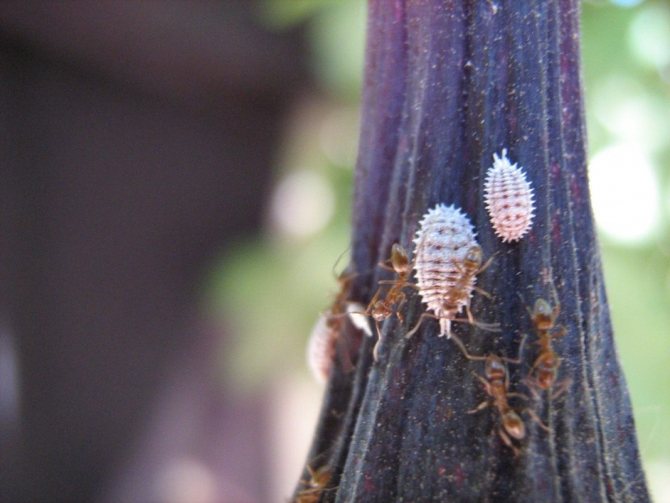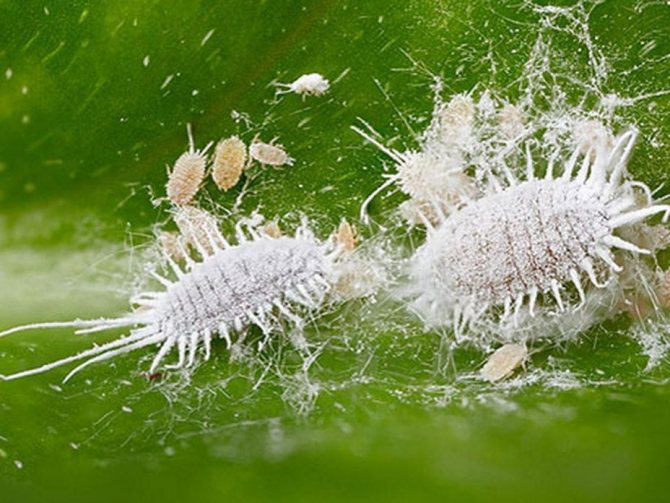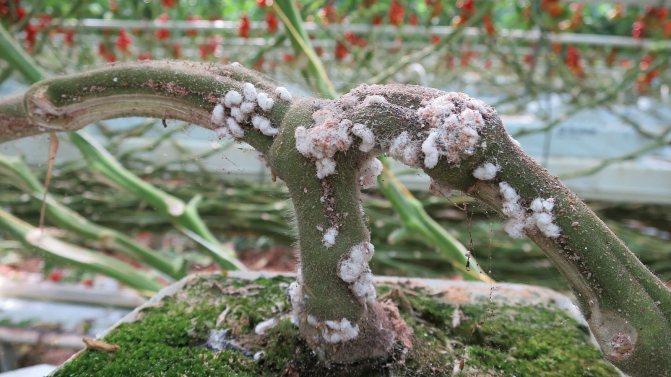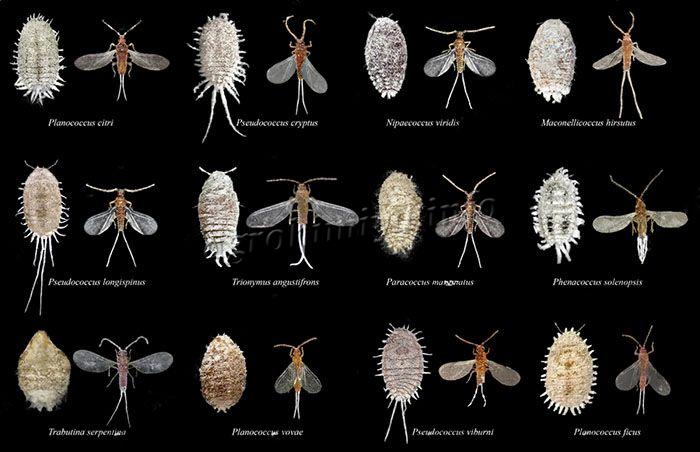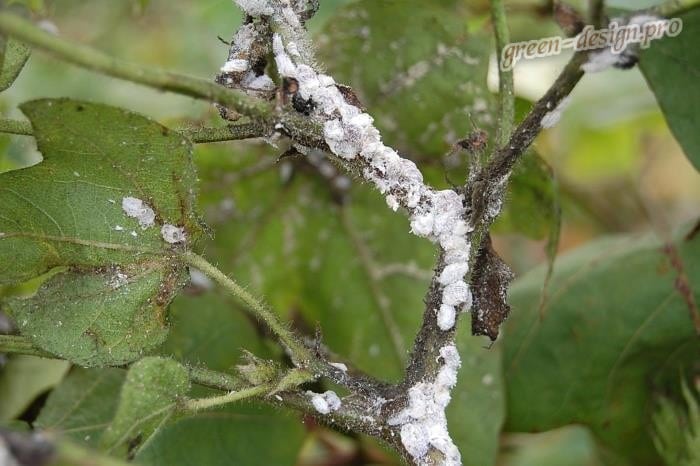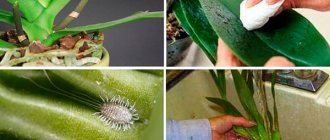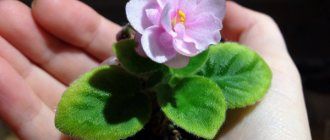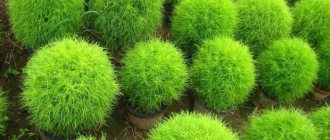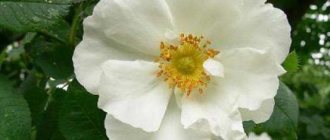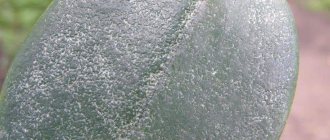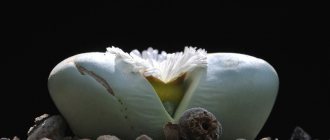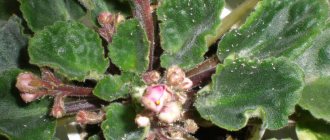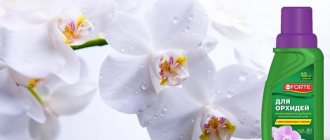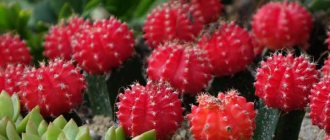Scale insects (Pseudococcidae) - the general name of the equally winged insects of the coccid suborder, uniting representatives of the family of lamellar, giant, steam-ferruginous and mealybugs, as well as felt insects - they are close relatives of the scale insect. These pests affect citrus fruits, amaryllis, azaleas, asparagus, cacti, lemons, palms, fuchsias, grapes, camellia, cissus, gerbera, oleander, philodendron, anthurium, monstera, hibiscus, Kalanchoe, cactus. They settle on shoots, stems, leaves, ovaries and fruits of plants, significantly slowing down their growth and development. Methods of dealing with mealybugs are in our publication.
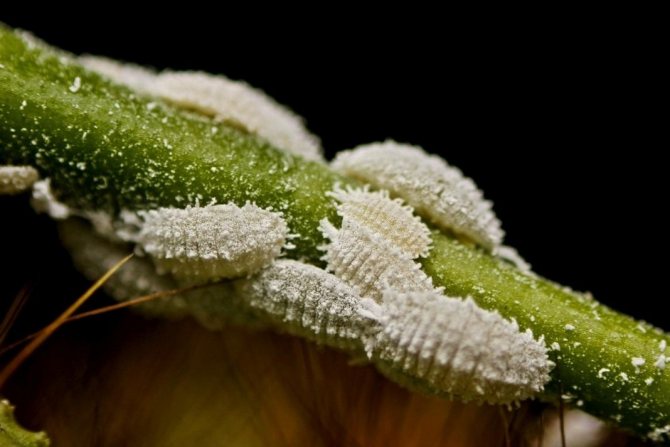
Mealybugs (Pseudococcidae).
Characteristic
Mealybugs are a large family of over 2,200 species. They are widespread almost everywhere and are able to exist normally both in the subtropics and in temperate climates, but representatives of most species are still concentrated in tropical zones.
On a note! About 330 species of mealybugs live on the territory of European countries!
Depending on the species, these parasites can infect fruit or industrial crops, ornamental or greenhouse plants. In the course of their life, mealybugs are mostly dispersed on the aerial parts of plants, but there are also species that live mainly in the thickness of the substrate and feed on rhizomes.
Description
The size of the mealybug's body depends on its species and can range from 0.5 to 12 mm. In this family, sexual dimorphism is pronounced - females and males differ markedly in physiological characteristics.
The male mealybug is hardly noticeable and is similar in appearance to a small mosquito. Its body is covered with a white powdery waxy coating. Long fragile tail filaments are located at the end of the abdomen. There are wings, in most cases, represented only by the first pair. Adult males do not feed and do not have a mouth apparatus.
The body of a female mealybug has an oval oblong shape and is divided into three main parts: head, chest and abdomen. In this case, the upper side of the body is somewhat convex, the lower one is flattened. The covers are soft. Representatives of some species have three pairs of small walking limbs, while others do not have them - the females of these species remain motionless throughout their lives. The body of females, as well as males of a mealybug, as can be seen in the photo, is covered with a whitish waxy powder coating, which can be either uniform or appear as a kind of bristles or outgrowths. The latter formations can be dispersed throughout the body or located exclusively along the edge or be located only at the end of the abdomen. There is an oral apparatus represented by a sucking organ.
Chemicals
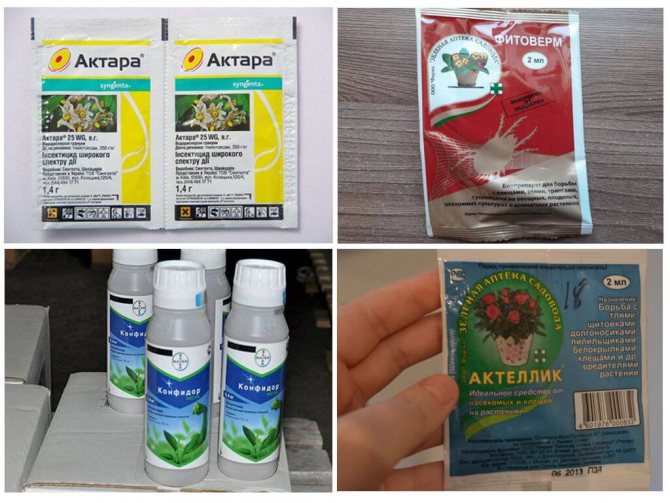

Mealybug chemicals
Mealybug preparations are sold in specialized stores in a huge assortment.
- Fitoverm. The drug is biologically active. Prepare a solution immediately before use. Dissolve 2 ml of the product in 1 liter of water. Repeat the treatment every week. To get rid of the mealybug completely requires about 8 treatments.
- Aktara. An extremely powerful broad spectrum insecticide.For 1.5 liters, only 1 g of the drug is required. The solution is sprayed on the plant, soil. Several treatments are required with a break of 2 weeks. Re-infection protection lasts for about a month. The active components penetrate into the sap of the plant, while feeding into the insect's body. Kills adults, larvae.
- Confidor. The action resembles the previous drug. From a mealybug, 1 g of Confidor is diluted in 500 ml of water. The composition does not harm the plant, retains its properties for up to 1 month. You can destroy pests in 2 procedures with a frequency of 14 days. A weaker solution is poured over the soil at the root.
- Actellic. The drug relieves mealybugs with severe infection. The product may only be used outdoors. You need to work with rubber gloves. The plant is sprayed a maximum of 3 times every 14 days. Pests die within 3 days after treatment.
- Tanrek. Insecticide of contact and intestinal action. The active ingredient causes muscle paralysis in the mealybug, a quick death. In leaves, shoots after treatment, it lasts about 1 month, in the ground - up to 60 days. Provides effective control, prevention.
To prevent massive infestation of all indoor plants, it is recommended to process all crops in the house. After applying an insecticidal agent, you should not put a plastic bag on the flower. It is necessary to re-spray in a timely manner. But when using folk remedies, such an action is recommended to increase humidity. Let the plant breathe for at least 30 minutes every day.
Reproduction and development
Some types of mealbugs are capable of successful reproduction without the participation of males. But even if the ratio of males and females is the same, when representatives of such species migrate to greenhouse conditions, a sharp change in the ratio towards an increase in the number of females is observed.
Fertility will also depend on the species and can range from 300 to 2000 eggs. Representatives of most species of mealybugs go through three stages of development: egg - larva - adult, however, in some species, live birth is observed.
On a note! One female can give from 2 to 4 generations per year!
Egg
Before laying the clutch, the female leaves the host plant on which she was feeding and goes to the shelter. There she weaves a cocoon from her fibrous secretions, into which she subsequently lays eggs.
Eggs in most cases have a rounded shape, whitish color and translucent structure. A caring mother fixes a cocoon with eggs in the axils of the leaves or along the central veins. The walls of such a bag are quite dense, so the eggs in it are well protected from water and high humidity.
Larva
After 5-10 days, a larva emerges from the egg, which, before becoming an adult, undergoes several molts. The larva of the first instar is insignificant, but at the same time it can move quite actively, since it already has three pairs of well-developed legs. Because of this, the young larvae were nicknamed "tramps".
Due to the absence of a wax coating, the mealybug larva is vulnerable, which makes it look for a special place for feeding, which should be not only comfortable, but also safe. After a suitable feeder has been found, the larva sticks to it and becomes immobile. Experiencing molting, it regains mobility and looks for a new place to feed.
After two molts, the larvae turn into males, after three molts - into females.
Signs of defeat
Pests are easy to recognize by their white powdery bloom. They can be found on the back of the leaf, or on the stems with severe infection. Occasionally appear on the soil in a flower pot.
The main symptoms of plant infection are sugar bloom and the development of a fungus.Larvae and adults suck out juices, as a result of which the plant loses its vitality.
Leaves curl, turn yellow, fall off. Young shoots dry, buds do not develop, inflorescences crumble. All forces are spent on restoring damaged areas, so the plant stops blooming, bearing fruit, and growth slows down.
On a note!
Mealybug often infects orchids, cacti, ficuses, succulents, crotons, citrus fruits, palms, and many other flower and fruit crops. Infection occurs from diseased plants, through the soil, open windows.
To prevent infection, houseplants should be inspected regularly. Especially if they get weaker, stop developing.
Plant infection: causes
The reason for the appearance of a mealybug is a whole complex of violations of plant maintenance and care:
- low room temperature;
- high air humidity;
- waterlogging of the substrate;
- accumulation of fallen plant debris.
In addition, do not forget that you can bring the mealybug yourself, for example, together with the infected soil or simply on a new plant purchased from the store. If you want to replenish your collection of indoor flowers, then any new specimen must first be quarantined for some time - about two weeks. And only after it can be placed on the same shelf with the rest of the plants.
In addition, it is advisable to regularly inspect all flowers for the presence of small white lumps on the surface of the leaves and stems. Infection will also be indicated by yellowed areas, deformed and dead leaves, including young ones, as well as a stop in growth. The plant becomes sickly and depressed in appearance.
Reasons for the appearance of the worm
In order for this insect to appear in the environment, favorable conditions are necessary. Such individuals can penetrate both into the house and into closed ground. Often, when purchasing a plant, a person does not even suspect that this small insect is already on a part of the leaf and can soon spread throughout the plant.
This dangerous insect is very active and begins to reproduce under the following conditions:
- Increased air temperature (+25 degrees).
- High humidity.
You also need to find out if the mealybug is harmful to humans, since the insect can get on the skin. In fact, it is not capable of causing significant harm to humans, but it can cause local allergies in the form of redness of the skin.
Harmfulness
Under favorable conditions, the mealybug multiplies very quickly and increases the number of the colony. But if the pest is detected on time, then the damage from it can be minimized.
Plants susceptible to mealybug infestation:
- philodendron;
- oleander;
- azalea;
- amaryllis;
- anthurium;
- gerbera;
- citrus;
- hibiscus;
- cacti;
- grapes;
- monstera;
- palm trees;
- fuchsia;
- asparagus;
- Kalanchoe;
- cissus;
- camellia.
What is the threat of the appearance of a mealybug on plants? As we have already said, the affected specimen, devoid of nutritious juices, will begin to lag behind in growth, the foliage will gradually turn yellow, curl and fall off. On the stems, you can notice the appearance of a sticky cotton bloom, which will spread very quickly throughout the body of the plant without intervention on your part. In addition, this whitish bloom is an excellent environment for the development of bacterial and fungal diseases, and since the mealybug can feed on almost any part of the plant, the roots are quite capable of being infected, which greatly complicates the situation. Being in the substrate, the affected rhizomes continue to rot, and the disease, meanwhile, spreads more and more. And if you do not catch yourself in time, then you can soon lose one, and sometimes several of your favorite green pets.
It is interesting! Certain types of mealybugs, despite their enormous harmfulness to plants, are very useful to humans. So, for example, representatives of the Cochineal species and lacquer insects secrete a substance called carmine, which is subsequently used in the manufacture of red paint!
Control methods
Mild lesions are easy to deal with. With a soft brush or cotton swab dipped in soapy water, clean the plant from worms and the white cotton-like secretions they form, and then spray it three times with an interval of 7-10 days with a solution of green soap (10-15 g per 1 liter of water), tobacco infusion , infusion of garlic or decoction of cyclamen. A good effect is given by alcohol treatment or treatment with a pharmacy tincture of calendula.
In case of severe damage, in addition to manual destruction, spray at intervals of 7-14 days with one of the following products: Aktara, Biotlin, Calypso, Confidant, Confidor, Mospilan, Tanrek, Fitoverm... You may have to try several different drugs and choose the most effective one.
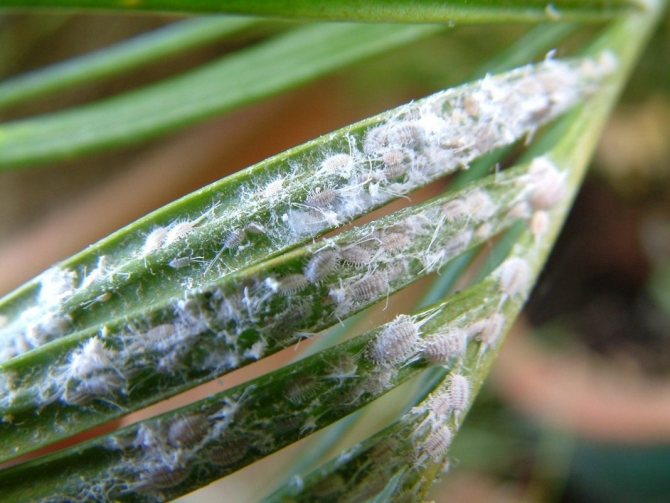

Mealybugs on the leaves of the plant.
Folk remedies
- Horsetail tincture. It is very good to water and spray diseased plants with horsetail tincture. Horsetail is sold in pharmacies and is used as a diuretic, as a blood purifier, etc. German name Schachtelhalmtee.
- Oil spraying agent. 1 liter of water is mixed with 2 tablespoons of olive oil and then the emulsion is applied to the plant (preferably by spraying).
- Alcoholic solution with soap. Treating the plant with a mixture of 15 grams of liquid soap, 10 ml of denatured alcohol (Brennspiritus) and 1 liter of warm water can also be successful.
- Garlic tincture. Take 4-5 cloves of garlic per 0.5 liters of water. The water must be brought to a boil, and the garlic must be finely chopped or squeezed. Then the garlic must be poured with boiling water, and insisted for at least four hours. The infusion is filtered and applied with a brush to the leaves undiluted.
Chemicals
The best time to use chemicals is when newly hatched juveniles leave the womb or egg sac. They are not yet covered with protective wax and are very vulnerable.
The complexity of the fight against mealybugs lies precisely in the fact that different generations of insects are on the plant at the same time, therefore a one-time application of an insecticide kills only young individuals, and after a while new ones hatch. In this regard, the use of drugs should be repeated several times every 7-14 days. The higher the stage of development of the larvae, the more difficult it is to deal with them.
Currently, a huge number of chemicals are sold in stores, including in the form of sprayers and sprays. After applying them to the plant, the protective chemical begins to be absorbed and enters the plant juices. Insects suck out such juice and poison themselves.
Preparations that, in addition to biologically active substances, also contain oil, have proven themselves very well in the fight against mealybugs. However, there are a number of disadvantages here. These medications should only be applied to affected areas and to areas that are considered potential insect hiding places.
When using sprays, before applying, you must carefully read what should be the minimum distance to the plant when applying, since the spray can damage the leaves very much.
On sale you can also find protective granules and so-called root sticks. Here it must be borne in mind that, in addition to protective substances, these products also contain fertilizer, therefore, before use, it is necessary to carefully study their composition, since the roots of many plant species are very sensitive to various kinds of salts, and can burn out very quickly. For such species, these drugs are not acceptable. Sometimes dilution of the drug in water can help in order to bring fertilizer and medicine to the roots in a lighter form.
When fighting mealybugs, it is necessary to repeat the procedures for exposure to chemicals in order to prevent the appearance of a new, more stable generation, therefore, you should carefully monitor the period of repeated exposure indicated on the package.
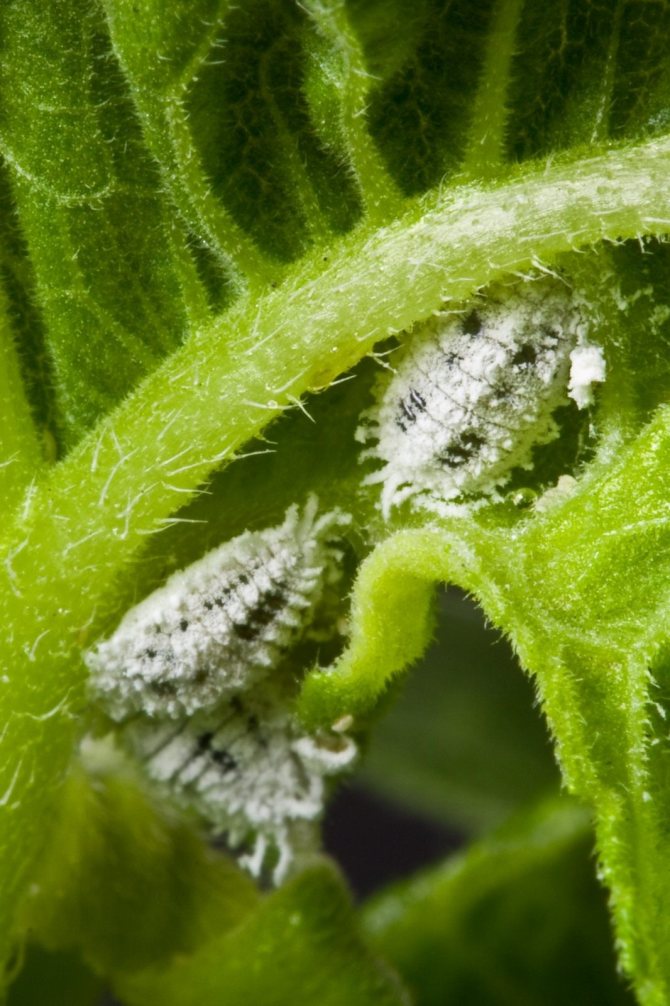

Mealybugs on the leaves of the plant.
Features of certain species
Absolutely all mealybugs, regardless of species, secrete a sticky secret, which is later transformed into a white cotton-like bloom. But at the same time, representatives of different species can have a different structure, and each will infect certain plants.
- Grape scale. As the name implies, it parasitizes on grape plantings. The body of adult females is oval, slightly widened at the sides. These parasites multiply very quickly and in a short time are able to quite strongly infect, and sometimes completely destroy large vineyards. Yellowed leaves and dry shoots indicate infection with grapebug.
- Seaside scale insect. The body length of this pest does not exceed 4 mm. The covers are gray or pinkish. The years fall in the summer months. Being at the larval stage of development, the parasite feeds constantly and after 5-6 weeks it turns into a sexually mature individual. When infected with the seaside worm, the plants do not bloom, do not develop and soon die.
- Bristly worm. The body length of the parasite often does not exceed 3.5 mm. The covers can have a pinkish or orange tint. Females of this species are viviparous and have well-developed walking limbs, due to which they very quickly settle in plants located at some distance from each other. Plants affected by the bristly worm receive characteristic damage: the leaves turn yellow, curl, fall off, the shoots stop growing. At the same time, settling on bulbous, the pest often crawls under the scales of leaves, in citrus fruits it crawls under the bark.
Remember that if you have a mealybug infestation, it is very important to take immediate steps to eliminate it. Careful and correct processing of plants will help prevent the spread of the pest to healthy flowers and crops and save infected specimens from death.
How to recognize an insect
There are a number of signs by which you can determine if a plant is infected:
- If you pay attention to the leaves or stems at the time of the appearance of the parasite, then nests will become noticeable on them.
- Drops appear on the plant, this is a harmful nectar that insects secrete.
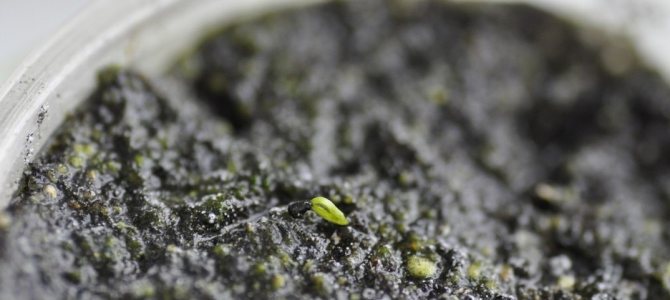

The appearance of the plant has deteriorated, it lags behind in growth, while the leaves lose their attractive appearance.
How to get rid of suckers or springtails on houseplants
The mealbug is an amazing insect, as it has an unusual property. If favorable conditions have ceased, the parasite is able to go into a half-asleep state for a while and stay in it until the air temperature and humidity reach the level for its life.
Mealybug development cycle
- Egg. Females lay their eggs in a felt cocoon. Some species are viviparous - they produce live larvae.
- The larvae move quickly, conquering new spaces, they are called "vagabonds". In some species, they are inactive. There is no gender distribution.
- Imago. After moulting, vagrants become adults, females and males.
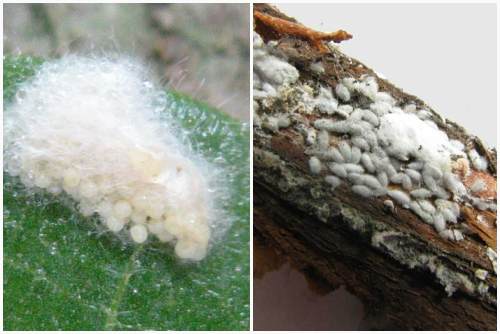

Harm from this insect
For a plant
The harm of such pests lies in the fact that, regardless of the type, they all feed on the sap of the plant. At the moment of absorbing the juice, they inject digestive enzymes into the flower, which are in their saliva. From this flower:
- weakens;
- dries;
- the leaves begin to fall.
In addition, all individuals leave behind a secret, in the place of which a sooty fungus appears.
Attention! Mealybugs usually settle on weakened plants.In such plants, a much smaller amount of protective substances is formed, which simplifies the life of the worms.
Is it dangerous to humans?
A person can be calm, this parasite is a threat only to plants. Mealybug is absolutely harmless to humans., unless you count the nerves spent worrying about your favorite indoor plants.
Preventive actions
To avoid the appearance of hairy lice, it is necessary to regularly examine the leaves, stems and flowers of plants at risk for the appearance of white spots. If a diseased flower is found, treat it with preparations and wipe the rest of the indoor plants that are in close proximity to each other with soapy water.
Attention! When acquiring a new green friend, you should not immediately put it with other houseplants. It is necessary to keep it in quarantine for some time.
Once every two weeks, it is necessary to wipe large leaves with a damp cloth and moisten the flowers with light spraying, removing dust and dirt from them. Also, when dry parts appear, remove them in a timely manner.
In general, mealybug is an unpleasant phenomenon that affects many flowering house shrubs and perennial flowers. You can get rid of it with prevention, timely detection and chemicals.
For which plants is the mealybug especially dangerous?
This pest is especially dangerous for plants with smooth leathery leaves. These include sansevieria, diffinbachia, pyzonia, alocasia, aglaonema and many others, it's hard to list everything. Cordilina and dracaena are often attacked by mealybugs. Owners of citrus fruits (lemons, tangerines, oranges) should also be on the lookout. Often attacks orchids, succulents and cacti.
How to start the fight against mealybug
At first glance, it is difficult to understand that a shrub is infected with an insect, since the culture is covered with a white bloom, similar to fungus or mold. Therefore, at the initial stage, it is important to decide what you still have to fight with. After that, you need to use one of the popular insect control methods. This can be done using proven chemicals or using folk methods. It is important to follow through and get rid of the pest completely. As a rule, it will take 10-12 days to completely defeat insects.
Attention! It is necessary to treat adjacent crops to avoid re-infection.
Prevention of insect development
In order not to poison yourself and plants with chemicals in the future, it is better to prevent the development of harmful insects. To do this, you should:
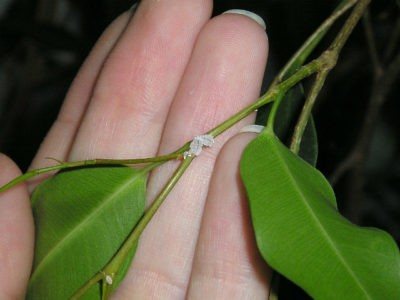

inspect the plant regularly;- replant flowers on time, renew soil in pots;
- follow all recommendations for the care of each particular flower;
- timely remove dried parts of the plant;
- disinfect the soil before planting;
- quarantine new flowers.
We all want our home to have a lot of greenery, and that this greenery was healthy and blooming. But for this you need to make an effort. Today we described in detail how to deal with one of the types of pests (what other types of worms are there and how to deal with them?). This information should help you take proper care of your plant. And for the conscientious care of the plant, we will certainly be thanked with clean air in the house.
Why does it appear


Typically, parasites begin to multiply when conditions are conducive to it. Pests can enter the apartment or into the ground, both with infected plants and with infected soil. There are times when growers themselves bring pests home on plant leaves or with seedlings, after purchasing them in a store.
The main conditions for the active reproduction of this parasite:
- High humidity.
- The temperature is about +25 degrees.
Popular drugs
- Karbofos... Available in two types: emulsion and powder. If ease of use is preferred, you should pay attention to the emulsion, but if you are interested in a low cost, purchase a powder. When processing, it is necessary to move the furniture as far as possible (pests can hide there too), then dilute the drug in the required proportion (strictly follow the instructions) and carry out the processing. The cost of a canister with a volume of 5 liters is 2500-3000 rubles, the cost of a powder is up to 50 rubles.
- Phosphamide... Excellent pest control. The only and very significant disadvantage is that it is highly toxic to animals. Getting poisoned is very simple, and if you do not consult a doctor in time, it can be fatal. It is applied by spraying.
- Metaphos... A small emulsion of 5 grams will cost 20 rubles. One of the most effective agents with a wide spectrum of action. It spreads very quickly throughout the plant, which means it quickly copes with pest control. It can be used as a single insecticide, since, as already mentioned above, it has a wide range of effects.
How to properly handle chemicals
Thoroughly dilute the insecticide with water in exact proportions (they are indicated in the instructions, for each plant, crop, an individual value is usually selected). Before this, it is necessary to prepare the territory on which the processing will be carried out. Move furniture as far as possible, remove bed linen, bedspreads (they can absorb the chemical).
Spray thoroughly, keeping in mind the inside of the leaves. Use protection or tight clothing that will cover your body and respiratory tract as much as possible (avoid breathing vapors!).
Then leave the room for a day, open the windows so that the substance evaporates faster. If there are pets in the house, move them out of the room as before processing.
If the insecticide gets inside, call your doctor immediately.
Habitat
Stems, branches, foliage, ovaries, fruits.
All lovers of greenery in the house need to know what a mealybug looks like, how to deal with it on indoor plants, as well as the main methods of preventing pest infestation. These creatures outwardly resemble aphids. Their size ranges from 3 to 7 mm. From above, the pests seem to be sprinkled with flour. This substance protects them from drying out, since they do not have an external solid chitinous apparatus. It is not difficult to recognize the presence of mealybugs, as they form a specific cotton-like bloom on the leaves. In these fluffy masses, the females of these pests can lay up to 500-600 eggs. This contributes to a very rapid spread of these creatures to neighboring colors.
If the degree of infection is low, it is quite possible to do with folk remedies, which are distinguished by a milder action and are completely harmless to humans and pets. If the first signs of leaf damage were not detected in a timely manner, it is necessary to use more effective and efficient chemicals and agricultural techniques to combat these creatures. In some cases, it is advisable to use all possible methods at once to more quickly eliminate pests from the leaves of indoor plants.
Folk remedies for the worm
- Soap solution... If this is not the first pest you encounter, you probably already realized that soap solution is one of the most universal folk ways to get rid of a pest. In a container, dilute a piece of household (tar) soap and 0.5-1 liter of water. Foam the resulting solution as much as possible and apply the foam to the leaves and stems. It is very important not to overdo it, so that too much solution does not fall on the soil and penetrate deep into the roots.
- Olive oil (about 2 tablespoons) dissolve in a liter of water. Spray the plants with this solution, every five days, in a course of 4 sprays.
- Calendula or horsetail powder (easy to find in a pharmacy) dilute in boiling water. Then, after cooling down, water the plant. The recommended proportion is 100 grams of powder per 1 liter of water.
- Dry cleaning... Take an old soft-bristled toothbrush and thoroughly clean the plant (don't forget about the interior). Then water the plant with a powerful stream of water. This will knock out insects and, if not completely, then at times reduce the population of the worm, this method can definitely
Biological way
More suitable for greenhouse or greenhouse holders. It's no secret that there are beneficial insects. They easily fight pests, devouring them and at the same time do not cause any harm to plants. For mealybugs, such insects are ladybugs, lacewings. Therefore, if you have the opportunity, be sure to get such assistants, they will significantly facilitate the struggle.
Folk methods of destruction
It is possible to successfully fight against hairy pests with the use of various folk remedies. Such measures are quite simple, help to completely destroy the worm and do not require financial costs.
First, you need to brush the plant with a damp brush, and then rinse with water everything that is left after cleaning. The underside and axils of the leaves must be treated especially carefully. For regular use (with an interval of several days), folk remedies are known from soap dissolved in water with the addition of garlic or onion juice.
A very effective soap and alcohol remedy. However, when applying it, it should be remembered that there should be no traces of mortar on the ground. The next day, the plant is washed with warm water. After a few days, the procedure is repeated.
An elementary remedy - tincture of garlic, horsetail, fragrant tobacco or calendula - helps to fight against the worm when there are no special preparations for pest control at hand.
You can get rid of insects and white bloom after mechanical cleaning of the plant with an ordinary hot shower. The hairy worm cannot stand high temperatures.

